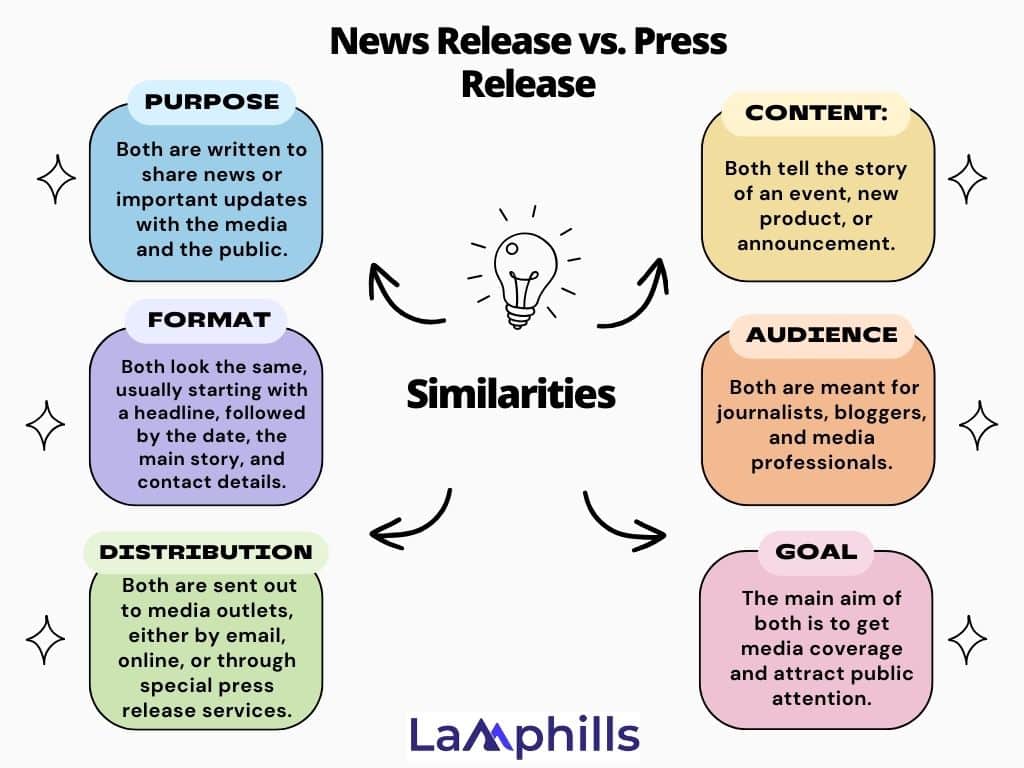News Release Vs Press Release: what’s the difference? Many people think these terms mean the same thing, but they don’t. For businesses, understanding the difference is important for your marketing and public relations strategy.
Both terms are often used to mean the same thing. There are also other terms for different types of public relations messages, not just press releases. While some people think there are small differences between press releases and news releases, these differences can be confusing
I remember the first time I had to write a press release. It was for a local nonprofit group launching a new community program. As a young PR specialist, I was excited but also nervous, wanting to make sure everything was perfect. I spent hours on it, thinking I had done a great job, only to have my boss ask, “Is this a press release or a news release?”
I was confused because I thought they were the same. That day started my journey into understanding the world of communications better. Now, I want to share what I’ve learned with you, so you can understand the difference between a news release and a press release and when to use each.
Key Points
- Audience: A news release targets everyone, including the public, stakeholders, and customers. A press release is aimed specifically at journalists and media professionals.
- Content: A news release covers general topics in an engaging style. A press release focuses on specific company news, like product launches or business changes, and is more formal and concise.
- Purpose: The main goal of a news release is to inform and engage a broad audience. A press release aims to attract media coverage and get featured in news outlets.
- Format: A news release has a flexible format with quotes, background info, and multimedia. A press release follows a strict format with a headline, dateline, intro, body, company info, and contact details.
- Distribution: A news release is shared through websites, social media, and email newsletters. A press release is sent directly to media contacts through distribution services to reach journalists and editors.
What is a Press Release?
A press release is a formal document sent to the media to announce something important. It follows a specific format, usually including a headline, dateline, introduction, body, and contact information. Press releases are meant to get the attention of journalists and editors, hoping they will cover the story.
From my experience, the best press releases are short and to the point. They focus on the “who, what, when, where, why, and how” of the story. For example, when I wrote a press release for a tech company launching a new product, I made sure to highlight the unique features, the launch date, and the potential impact on the industry. This approach helped get media coverage and increased interest.
Read Also: Press Release Examples to Inspire You in 2024 (+ Expert Tips & Templates)
What is a News Release?
Although “news release” and “press release” are often used interchangeably, there are differences. A news release is a broader term that includes any announcement sent to the media. It’s not just limited to formal press releases but also includes media advisories, news briefs, and feature articles.
In my career, I’ve found that news releases are often more flexible in format and tone. They can be used for many purposes beyond just announcing an event or product launch. For example, I once wrote a news release for a client that told the story of their company’s journey and milestones. This piece was picked up by several lifestyle and business publications, giving the company good exposure.
News Release vs. Press Release: How are they Different?
No matter what you call it, a release is made and shared to highlight news from an organization and inform its target audience. A press release or news release can cover many topics and apply to various industries. Here are the major differences between the both terms:
#1. Audience
News Release: A news release is intended for a broad audience, including the general public, stakeholders, customers, and anyone interested in the information. It is designed to be accessible and understandable to a wide range of readers.
Press Release: A press release is specifically targeted at journalists, editors, and media professionals. Its primary goal is to provide enough information and a compelling story angle for media outlets to pick up and cover the news.
#2. Content

News Release: The content of a news release typically includes general information about an event, development, or newsworthy topic. It can cover a variety of subjects, such as community events, public announcements, or organizational updates, and is often written in a more engaging and narrative style.
Press Release: A press release focuses on company-specific news or events, such as product launches, business milestones, mergers, or significant changes within the organization. It tends to be more formal and concise, sticking to the facts and essential details to make it easy for journalists to extract key points.
#3. Purpose
News Release: The primary purpose of a news release is to inform the public about something newsworthy. It aims to raise awareness, share important updates, and engage with a broad audience. It’s about getting the word out to as many people as possible.
Press Release: The purpose of a press release is to attract media coverage and generate publicity. It aims to catch the attention of journalists and media outlets, providing them with a story that they can further investigate, write about, or broadcast. The ultimate goal is to get the news featured in various media channels.
#4. Format
News Release: The format of a news release is more flexible and can vary depending on the nature of the news and the intended audience. It might include quotes, background information, multimedia elements like photos or videos, and a narrative style that makes it engaging for readers.
Press Release: A press release follows a more rigid and standardized format. It typically includes a headline, dateline, introduction (the “lede”), body paragraphs, boilerplate information about the company, and contact details. This format is designed to make it easy for journalists to quickly understand the key points and find the information they need.
#5. Distribution
News Release: News releases can be distributed through a variety of channels, including the company’s website, social media platforms, email newsletters, and public relations websites. The goal is to reach as many people as possible, wherever they might be consuming news.
Press Release: Press releases are often sent directly to a targeted list of media contacts, such as journalists, editors, and news outlets. They might be distributed through press release distribution services or media databases to ensure they reach the right professionals who are likely to cover the story. The focus is on reaching media professionals who can amplify the news through their platforms.
#6. Call to Action (CTA)

Image by Leadferno
News Release: In a news release, the call to action (CTA) tells readers what to do next. It could be something like visiting a website, signing up for a newsletter, or attending an event. The CTA is usually clear and direct, encouraging readers to take immediate action.
Press Release: In a press release, the call to action is aimed at journalists and media outlets. It might ask them to contact you for more information, schedule an interview, or publish a story. The CTA in a press release is focused on getting media coverage and spreading the news.
#7. Timing
News Release: A news release is usually about something timely or current. It should be sent out when the news is happening or very soon after. For example, if a company is launching a new product, the news release should go out on the launch day or just before.
Press Release: A press release can be more flexible. It’s used to announce things like company updates, events, or achievements. You can plan the timing of a press release to coincide with strategic moments, such as before a big event or during a slow news period to get more attention.
In summary, a news release is about “now,” while a press release can be more planned out.
Below is a checklist comparing a News Release Vs. a Press Release
News Release vs. Press Release: When to Use Each
Often used in public relations or marketing, a press release or news release aims to get results. This could mean more visitors to a website, more people visiting a store, more media coverage, more social media engagement, or more sales. A release is important for sharing news with business media, industry publications, associations, and financial and consumer audiences.
When to Use a Press Release
Press releases are best for formal announcements that need immediate media attention. Here are a few situations where a press release would be suitable:
- Product launches: Highlighting new features, benefits, and availability.
- Company news: Announcing mergers, acquisitions, or significant business milestones.
- Event announcements: Promoting upcoming events, conferences, or webinars.
- Crisis communication: Addressing issues or crises with official statements.
In my practice, I recall a time when our company had to announce a major rebranding. We used a press release to give the media all the necessary details, including the reasons behind the rebrand and the expected impact. This helped us control the story and maintain a positive image during the transition.
When to Use a News Release
News releases are ideal for broader communication needs that may not need immediate media coverage. Consider using a news release for:
- Human interest stories: Sharing compelling stories about people or communities.
- Industry insights: Providing expert commentary or analysis on industry trends.
- Company updates: Offering updates that may not be time-sensitive but are still newsworthy.
- Feature articles: Crafting longer, narrative-driven pieces that provide depth and context.
I once worked with a nonprofit organization that wanted to share the impact of their work on local communities. Instead of a standard press release, we wrote a news release that told the story of one particular family whose lives had been transformed. This heartfelt story resonated with several media outlets, resulting in extensive coverage and support for the organization.
News Release vs. Press Release: Similarities

Press releases and news releases are very similar, which is why people often confuse them. The main similarities between a press release and a news release are:
1. Purpose: Both are written to share news or important updates with the media and the public.
2. Content: Both tell the story of an event, new product, or announcement.
3. Format: Both look the same, usually starting with a headline, followed by the date, the main story, and contact details.
4. Audience: Both are meant for journalists, bloggers, and media professionals.
5. Distribution: Both are sent out to media outlets, either by email, online, or through special press release services.
6. Goal: The main aim of both is to get media coverage and attract public attention.
News Release vs. Press Release: How to Write Effective Releases
Creating an effective press or news release needs creativity and a good structure. You also need to understand the type of announcement and who the audience is. Here are some tips for writing well-formatted releases.
Writing a News Release
Writing a news release is a bit different and allows for more creativity. While it doesn’t have a strict structure, it usually includes:
- A catchy headline that feels urgent and important
- A subheading that supports the main title
- An introduction that highlights the main ideas
- A body with all necessary details, answers to key questions, and supporting evidence
- A summary with key points and contact information
Writing a Press Release
A press release is more organized and follows a specific format to make it easy for reporters to understand your news. It shares some elements with news releases, like a headline, subheading, content body, and contact details. Additional points for a press release include:
- A lead paragraph that covers all essential details
- Quotes from leaders or celebrities toward the end
- A boilerplate section that is similar to an “About Us” part of the brand
- Use of persuasive words, phrases, and unique selling points of the business
Conclusion
Understanding the difference between a press release and a news release is crucial for effective communication. While both serve to inform the media and the public, knowing when to use each can greatly affect the success of your message. My journey in PR has taught me that the right approach can secure media coverage and build lasting relationships with journalists and audiences.
Next time you have a story to tell or an announcement to make, consider whether a press release or a news release is the best tool for the job. By doing so, you’ll ensure your message is delivered in the most effective and impactful way possible.
Frequently Asked Questions
What counts as a news release?
A press release is a written message sent to the media to share news, events, or information about a business, organization, or person.
How to write a news release?
The essential tool to help you share your story:
- Write a clear and interesting headline.
- Include the release date and your location.
- Quickly tell the main points.
- Provide more details afterward.
- Be honest and fair.
- Avoid using complicated industry terms.
- Add relevant and engaging quotes.
- End in a professional manner.
How many pages is a news release?
A good length for a press release is between 300 and 400 words. It should fit on one page, including spacing and formatting.
Is a press release a newspaper?
A press release is not the same as a news story. They have different goals. A news story aims to give the public unbiased information about an event or development, showing all sides. A press release, however, aims to promote the client’s interests.
What is the difference between a press release and a newsletter?
A press release shares news about something that will happen in the future, while a news release talks about something happening now or in the past. Press releases are linked to news channels, and news releases are often found online.
What is the difference between a press release Vs PR?
A press release is a written announcement sent to the media to share news. Public relations (PR) is a broader communication strategy that focuses on managing relationships and how people see an organization over time.
What is the difference between a press release and a communiqué?
A press release is usually sent to news media electronically and is ready to use. It often has a “do not use before” time, called a news embargo. A communiqué is a special type of press release, which is a short report or statement released by a public agency.
Related Articles:
Where to Send Press Release in 9 Steps (My Expert Tips)
My Most Effective News Release Templates for the Best Results
Press Release Examples to Inspire You in 2024 (+ Expert Tips & Templates)






